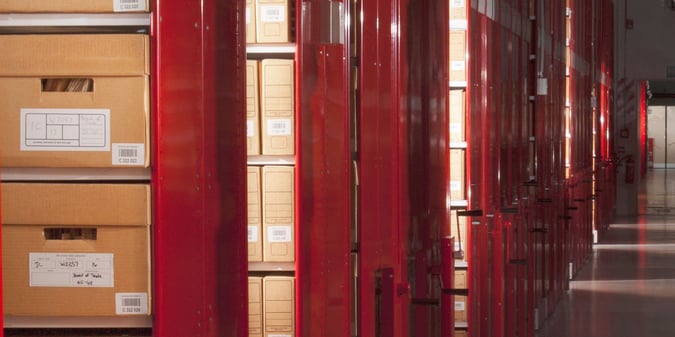
Storing records, collections, and objects in off-site and remote storage facilities limits access to original materials. Decisions about storage affect how your staff and clientele work and their ability to access information in a timely manner. The best storage solutions minimize disruption of service and frustration.
Essential Criteria
Two essential criteria to consider before embarking on any decision making are: the mission statement or purpose of the institution, its services, and client base, and collection development policies or what your collection consists of. If this makes you think back to introductory MLIS courses, it should, for all decisions hinge on these two criteria.
Mission or purpose statements are the cornerstone of all institutions. They represent what the institution and department, division, or office stands for, and what are we aim to accomplish or provide to our customer base.
Collection development policies are the backbones of any project. We need to remind ourselves about:
- what we collect
- who constitutes our customer base
- why and how our materials, data, objects, or information help them do their jobs
Keeping these core criteria in mind, let’s consider what triggers your decisions to move collections off site.
What triggers decisions to relocate collections?
Municipal record centers, courthouse records, and institutional and organization collections have common problems that trigger decisions to relocate collections. Lack of space is the most common problem/trigger for moving collections into storage. As paper records continue to expand and available space for records does not, the need to maintain access to intellectual content increases and off-site storage becomes imperative. This is particularly true in municipal record centers and court houses, but also in cultural institutions and information centers.
Revitalized records programs and retention schedules result in moving inactive materials into remote storage awaiting scheduled destruction. Records retention re-evaluation includes moving materials of legal and historical value to secure off-site and remote storage facilities for long-term and permanent retention.
Digitization projects for active and inactive collections free up space while moving physical materials off-site and providing access to surrogates and facsimiles via databases, indices, and digitized images.
Renovation projects include temporary storage in off-site locations and often result in the decision to store lesser used items remotely for the long term. Moving collections to a new building, location, or floor also triggers decisions to store materials off-site.
Other types of projects that trigger decisions to move collections to off-site storage are:
- Inventory and shelf reading projects
- Removal of duplicate materials
- Reduction in staffing or budget
- Preservation assessment projects that result in moving brittle, fragile, and perhaps rarer materials to environmentally controlled off-site storage
Decisions and solutions
Moving physical collections to another location is often beyond our control, particularly in the cases of outgrowing limited space and renovation. In these instances, a local off-site storage solution works best. Keeping the purpose for your collections, their scope, and your client base and their research needs in mind is imperative. Nearby off-site facilities provide easy access to retrieve materials that haven’t been digitized.
Common sense says to move duplicates, duplicated and digitized materials, journals that are online, and lesser used materials off-site, and provide access to heavily used materials or digital images in local service areas, reading rooms, and through inter – and intranets. Having a service area or reading room at the off-site facility for researchers who require immediate access to stored documents, improves customer service.
Digitization projects that include current and actively used documents or older, fragile collections, provide an easy justification for moving the originals to off-site and remote storage facilities for long-term content retention. While digitized records are retrievable through local databases and indices, the originals are available for those who need to consult them. Of course, storage of backups of the digitized and born-digital records is imperative; these can be retained either in local IT centers or off-site storage facilities.
Temporary off-site storage triggered by renovation of buildings or moving to a new location results in boxing materials and storing them for a short period, usually a year or less. While all materials might be moved, presorting heavily-requested items based on use enhances accessibility. Less frequently requested items could remain in storage when the service areas are fully renovated. Knowledge of the collections, their uses, and researchers’ needs is imperative when making these storage decisions.
An active records retention schedule and program includes criteria for storage of inactive records prior to destruction. Materials slated for short-term retention prior to destruction include inactive office records, many financial records, reports, and duplicate documents. Some of these records are also found in municipal centers and courthouses. Retention periods range from five to seven years, or longer, depending upon legal requirements and tax reporting schedules. Storing these materials in off-site and remote records storage facilities is routine. Records are retrievable should they be needed; a most irregular occurrence.
Records management programs identify materials of long-term, legal, and historical value found in municipal record centers and courthouses, offices, and cultural institutions. These paper materials are routinely digitized and/or microfilmed. The digitized records are then available in online databases while physical records are often stored off-site for retrieval upon request.
Materials in fragile condition should be duplicated and the originals stored away from active use. The same is true of items that have been duplicated on microfilm, microfiche, and through scanning. Access through document delivery enhances accessibility to poorly duplicated and illegible images. A regular delivery schedule, clearly noted on websites and databases, improves researchers’ productivity.
Unprocessed and recently received materials are often stored off-site awaiting processing and cataloging. The danger of this decision is that the contents and condition of unprocessed materials are unknown. Minimal level identification following the recommendations of “More Product, Less Process” (MPLP)* provides basic access to the collection through online catalogs and databases.
Summing it up
Off-site storage requires careful consideration and decisions based upon users, use of collections, and timely access to storage materials. The best storage solutions minimize disruption of service and consider potential researcher frustration.
In my next post on this topic, I’ll address preservation issues associated with off-site storage, including include security, risk management, insurance, and disaster response.
* Mark Greene and Dennis Meissner, “More Product, Less Process: Revamping Traditional Archival Processing” The American Archivist 68 No. 2 (Fall/Winter 2005) pp. 208-263

